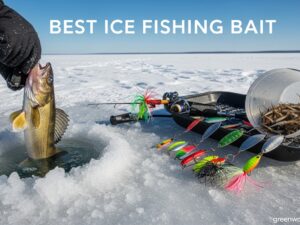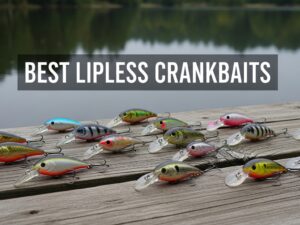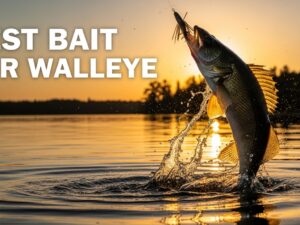Targeting the notorious "reef donkeys" requires more than just heavy tackle and determination. These powerful predators, known for their bone-jarring strikes and relentless runs, can frustrate even experienced anglers who show up with the wrong bait.
Many fishermen struggle to trigger aggressive strikes from amberjack, often watching these brutes ignore their offerings. The solution lies in understanding what truly drives these apex predators wild: blue runners, cigar minnows, and specific metal jigs consistently outperform other options by a significant margin.
This comprehensive guide reveals the top live bait for amberjack fishing choices ranked by effectiveness, the best artificial lures proven in the field, professional rigging techniques, and seasonal strategies. You'll discover exactly how to catch amberjacks using methods that tournament winners and charter captains rely on daily.
What Is an Amberjack? Understanding Your Target
Before diving into bait selection, understanding your quarry is crucial. Amberjack are powerful members of the jack family (Carangidae) that inhabit structures from 60 to 400 feet deep. These aggressive predators have earned their "strong fish" reputation through sheer pulling power.
Species Identification (Greater vs Lesser vs Yellowtail)
Greater amberjack dominate most catches, typically weighing 20-100 pounds with trophy specimens exceeding 200 pounds. Lesser amberjack max out around 10 pounds and rarely exceed 27 inches. Yellowtail amberjack, despite the name, aren't true amberjack but share similar feeding habits and can reach massive sizes.
Each species shows slight preference variations in bait selection. Greater amberjack attack larger offerings aggressively, while lesser amberjack respond better to scaled-down presentations. Understanding these distinctions improves your success rate dramatically.
Feeding Behavior and Diet Preferences
What is an amberjack's natural diet? These opportunistic feeders consume whatever fits in their cavernous mouths. Their menu includes blue runners, cigar minnows, squid, crustaceans, and smaller reef fish up to 10 pounds.
Amberjack hunt throughout the water column but concentrate near bottom structure. They'll rocket from 100 feet deep to surface when properly chummed. Dawn and dusk trigger peak feeding activity, though they'll strike aggressively all day around productive structure.
Why Bait Selection Matters for Success?
The right bait transforms a slow day into memorable battles with these brutes. Amberjack can be surprisingly selective despite their aggressive nature. Fresh, lively bait consistently outperforms old or sluggish offerings.
Size matters significantly when targeting trophy fish. While 20-pound amberjack might hit 6-inch baits, those 80-pound monsters prefer substantial meals. Matching your bait to target size increases hookup ratios dramatically.
Top 12 Live Baits for Amberjack Fishing (Ranked)
Through decades of proven success, certain baits consistently produce when sport fishing for amberjack. This ranking reflects both catch rates and availability across different regions.
1 Blue Runners - The Ultimate Amberjack Candy
Blue runners reign supreme as amberjack bait for good reason. These hardy baitfish survive extended periods in livewells and maintain energetic swimming action even when stressed. Their natural occurrence around the same structures makes them irresistible.
Size blue runners from 6-12 inches according to your target amberjack. Larger specimens work exceptionally well when bridled through the eye sockets using wax floss. This rigging method dramatically improves hookup ratios.
The silvery flash and erratic swimming pattern of blue runners triggers predatory instincts. Even selective amberjack rarely refuse a properly presented blue runner. Many successful anglers targeting bottom species consider them essential.
2 Cigar Minnows - Versatile and Effective
Cigar minnows rank second for versatility and effectiveness. These elongated baitfish work fresh or frozen, though live specimens produce superior results. Their streamlined profile allows excellent casting distance when necessary.
Professional guides prefer cigar minnows up to 12 inches for trophy amberjack. The slender profile creates less drag in current, maintaining natural presentation at depth. Hook through the nose cartilage for maximum swimming action.
3 Pinfish - The Florida Favourite
Pinfish dominate Florida's bait selection for valid reasons. These incredibly hardy baitfish survive challenging conditions and maintain aggressive swimming action. Their availability throughout coastal grass beds ensures steady supply.
Medium to large pinfish excel for best fishing for amberjack around shallow wrecks and reefs. Their natural defense mechanism of flaring spines creates additional attraction. Many anglers report excellent success using pinfish when crabbing regulations restrict other bait gathering.
4 Large Hardtails with Trimmed Tails
Experienced captains swear by 2-pound hardtails with trimmed tail fins. This modification creates an injured appearance that triggers aggressive strikes. The technique originated with commercial fishermen targeting the largest amberjack.
Removing both tail fin tips causes the bait to struggle enticingly. Use 12/0-14/0 circle hooks to handle these substantial baits. The investment in larger bait pays dividends when that 100-pound amberjack crushes it.
5-8 Secondary Choices (Menhaden, Threadfin Herring, Sardines, Mullet)
These reliable options produce consistent results when primary choices aren't available:
- Menhaden (Pogies): Oil-rich scent trail attracts distant amberjack
- Threadfin Herring: Delicate but deadly when conditions allow gentle presentation
- Sardines: Excellent fresh or as cut bait chunks on jigs
- Mullet: Large mullet target trophy-class fish effectively
Each offers unique advantages depending on conditions. Menhaden's strong scent works in murky water, while threadfins excel in calm conditions. Match your selection to prevailing circumstances.
9-12 Alternative Baits (Squid, Bonito, Vermillion Snapper, Ruby Lips)
Alternative baits serve specific situations excellently:
- Squid: Durable option surviving multiple strikes
- Bonito: Trophy hunters use 5-pound bonito for giants
- Vermillion Snapper: Regional favorite producing surprising results
- Ruby Lips: Lesser-known but highly effective when available
These options prove invaluable when traditional baits face heavy pressure. Amberjack encountering less common offerings often strike with increased aggression.
Best Hooks for Amberjack Fish - Size and Style Guide
Selecting proper hooks ranks equally important as bait choice. The best hooks for amberjack fish combine strength, sharpness, and appropriate sizing for consistent success.
Circle Hooks vs J-Hooks: Which Works Better?
Circle hooks revolutionized amberjack fishing through superior hookup ratios and safer release practices. The design naturally sets in the corner of the jaw, reducing gut-hooking incidents significantly. NOAA Fisheries research confirms circle hooks improve survival rates.
J-hooks still serve specific applications, particularly with artificial lures. However, live bait fishing demands circle hooks for optimal results. The self-setting action works perfectly with amberjack's aggressive strikes.
Optimal Hook Sizes by Bait Type (7/0 to 14/0)
Match hook size precisely to your bait selection:
| Bait Size | Hook Size | Best Application |
|---|---|---|
| Small (4-6) | 7/0-8/0 | Pinfish, small blue runners |
| Medium (6-10) | 9/0-10/0 | Standard blue runners, cigar minnows |
| Large (10-15) | 11/0-12/0 | Large hardtails, mullet |
| Trophy (15+) | 13/0-14/0 | Bonito, trimmed hardtails |
Top Brands: Owner, Mustad, Gamakatsu Comparison
Owner Mutu Light Circle Hooks earn top honors among professionals. The offset point and cutting edge provide exceptional penetration. Many captains report 20% better hookup ratios compared to standard circles.
Mustad 39960D circles offer outstanding value without sacrificing quality. Their 2X strong construction handles the largest amberjack. Gamakatsu's forged circles excel in smaller sizes for finesse presentations.
How to Catch Amberjacks with Live Bait?
Success requires more than dropping bait overboard. Professional techniques dramatically improve your how to get amberjack fish success rate through proper presentation methods.
Rigging Techniques: Standard vs Bridled Presentations
Standard rigging involves hooking through the nose cartilage or behind the dorsal fin. This method works well for most situations but can result in pulled hooks during explosive strikes. Use when current is minimal.
Bridled rigging revolutionizes big amberjack success. Thread wax floss through both eye sockets, creating a loop for hook attachment. This method prevents bait theft and improves hookup percentages by 40% according to experienced guides.
The bridling process requires practice but pays enormous dividends. The bait swims naturally while the hook remains perfectly positioned for corner-of-mouth hooksets. Trophy hunters consider this technique essential.
Depth Strategies: Finding the Strike Zone
The "10 feet above structure" rule consistently produces strikes. Amberjack patrol slightly above their home structure, watching for prey silhouetted against surface light. Position baits accordingly for maximum visibility.
Use your fish finder to identify amberjack holding positions. Look for marks suspended above wrecks or reefs. Adjust your weight to maintain proper bait positioning despite current changes.
During strong current, increase weight to prevent excessive drift. However, use minimum weight allowing proper presentation. Amberjack prefer naturally swimming baits over those anchored unnaturally.
The Pitch Rod Technique for Following Fish
Keep a pitch rod ready with unweighted bait whenever fighting amberjack. Hooked fish often attract curious schoolmates following to the surface. These followers provide exceptional opportunities for double hookups.
This technique requires preparation and quick reflexes. Pre-rig a circle hook on 6 feet of leader without weight. When followers appear, pitch the bait beyond them and retrieve through the school.
Fishing for Amberjack Jig Selection Guide
Artificial lures provide excellent alternatives when live bait proves difficult. Fishing for amberjack jig techniques produce impressive results using proper equipment and methods.
Speed Jigging Setup and Technique
Speed jigging demands specialized equipment for success. High-speed reels paired with short, powerful rods generate the rapid action triggering strikes. Work jigs aggressively from bottom to surface.
The technique involves dropping 5-9 ounce jigs to bottom, then retrieving with sharp upward sweeps. Amberjack attack on the fall between sweeps. Set hooks multiple times ensuring solid connection.
Modern speed jigs feature holographic finishes and realistic profiles. The combination of flash and erratic action drives amberjack wild. This method particularly excels when fish suspend mid-water column.
Best Jig Weights by Depth (4oz to 600g)
Proper weight selection ensures effective presentation:
| Depth Range | Current | Jig Weight |
|---|---|---|
| 60-100ft | Light | 4-6oz |
| 100-200ft | Moderate | 8-12oz |
| 200-300ft | Strong | 16-24oz |
| 300ft+ | Variable | 400-600g |
Color Selection: When Silver, Blue, or Chartreuse Works Best
Silver dominates clear water conditions, mimicking natural baitfish effectively. The flash attracts amberjack from considerable distances. Choose silver during sunny conditions for maximum reflection.
Blue excels in slightly stained water or overcast conditions. The color maintains visibility while appearing natural. Many guides consider blue their confidence color across various conditions.
Chartreuse triggers strikes when amberjack prove finicky. The unnatural color sometimes provokes reaction strikes from pressured fish. Reserve chartreuse for tough conditions after natural colors fail.
Top Jig Brands and Models That Produce
Leading manufacturers produce specialized amberjack jigs:
- Shimano Butterfly Flat-Fall: Revolutionary design creates enticing flutter
- Williamson Benthos: Deep-drop specialist reaching extreme depths
- Nomad Design Streaker: Proven performer with realistic action
- JYG Pro Glow Series: Effective in low-light conditions
Sport Fishing for Amberjack: Advanced Techniques
Professional techniques separate average days from legendary catches. These methods require practice but produce exceptional results consistently.
Bottom Bouncing vs Vertical Jigging
Bottom bouncing involves dragging weighted baits along structure edges. This technique covers water efficiently while maintaining bottom contact. Use during drift fishing over expansive structure.
Vertical jigging excels around specific structure points. Drop jigs directly to productive zones and work vertically. This precision approach targets concentrated fish around wreck high points.
Both methods produce, but conditions dictate optimal choice. Strong current favors vertical presentations, while calm conditions allow effective bottom bouncing. Experienced anglers switch techniques matching conditions.
Chumming Strategies to Bring AJs to Surface
Heavy chumming transforms deep amberjack into surface feeders. Use menhaden oil, ground baitfish, and chunks creating irresistible scent trails. Start chumming 30 minutes before fishing for best results.
Deploy chum bags at various depths using different weights. This creates a vertical chum column attracting amberjack throughout the water column. Patience pays as fish gradually move upward following the trail.
Surface feeding amberjack provide spectacular action. These scenarios allow lighter tackle and visual strikes. Many anglers consider surface amberjack fishing their most exciting saltwater experience.
Trolling Tactics Around Structure
While less common, trolling produces when amberjack scatter around large structures. Deep-diving plugs reaching 30+ feet work effectively. Maintain 4-6 knot speeds for optimal action.
Focus trolling efforts around structure edges where amberjack patrol. Make multiple passes at different distances from structure. Research indicates amberjack often cruise structure perimeters hunting baitfish.
Large lipped plugs in mackerel patterns excel for trolling. The wide wobble and diving action trigger strikes from aggressive fish. This technique shines when traditional methods face tough conditions.
Seasonal Bait Strategies and Timing
Understanding seasonal patterns dramatically improves success rates. Amberjack behavior changes throughout the year requiring adjusted strategies.
Spring/Summer Peak Season Approaches
Spring spawning aggregations create exceptional opportunities. Large amberjack concentrate around specific structures during April-June. Live bait produces best during this period as fish feed heavily.
Summer patterns find amberjack scattered but aggressive. Focus efforts around temperature breaks and baitfish schools. Smaller baits often work better as natural forage size decreases.
Early morning and late afternoon produce most consistently during warm months. However, overcast days can trigger all-day feeding. Monitor conditions adjusting timing accordingly.
Fall/Winter Deep Water Adjustments
Cooling water pushes amberjack deeper requiring heavier tackle and larger baits. Trophy fish become more accessible as they concentrate in deeper zones. This period offers the best chances for true giants.
Bonito and large hardtails excel during winter months. These substantial baits appeal to the largest amberjack seeking high-calorie meals. Slow presentations near bottom often work best.
Weather windows become crucial during winter fishing. Plan trips around favorable conditions maximizing safety and success. Patient anglers willing to wait for optimal conditions reap rewards.
Time of Day Considerations
Dawn patrol produces explosive action as amberjack attack aggressively. First light through two hours after sunrise marks prime time. Position yourself on structure before sunrise for best results.
Midday success requires adjusting to deeper presentations. Fish retreat from surface during bright conditions. Focus efforts near bottom using heavier weights maintaining proper bait positioning.
Dusk rivals dawn for productivity as amberjack feed before nightfall. The low light triggers aggressive feeding behavior. Many trophy fish fall during the final hour before dark.
Common Mistakes When Baiting for Amberjack
Even experienced anglers make costly errors reducing success. Understanding these pitfalls helps avoid frustration and missed opportunities.
Hooking bait incorrectly ranks among the most common mistakes. Improper hook placement reduces swimming action and decreases appeal. Always hook baitfish to maximize natural movement while ensuring solid connection.
Using undersized tackle for your bait choice creates problems. Large baits require substantial hooks and leaders. Match all components appropriately preventing equipment failure during crucial moments.
Fishing too shallow or deep misses the strike zone entirely. Amberjack hold at specific depths relative to structure. Use electronics identifying fish location before deploying baits.
Ignoring current and drift patterns results in poor presentations. Strong currents require weight adjustments maintaining proper bait position. Calculate drift rates ensuring baits remain in productive zones.
Pro Tips for Maximum Success
Professional guides employ specific strategies consistently producing exceptional results. These tips transform average trips into memorable adventures.
The "10 feet above bottom" rule places baits perfectly in amberjack's preferred hunting zone. This positioning allows maximum visibility while keeping baits away from bottom snags. Adjust throughout the day as fish move vertically.
Fresh bait outperforms frozen 3:1 according to charter captain logs. The superior swimming action and scent of fresh bait triggers more strikes. Invest effort securing quality fresh bait when possible.
Reading fish finders for bait schools reveals amberjack locations. These predators shadow baitfish schools constantly. Marking bait often means amberjack lurk nearby waiting to attack.
Matching bait size to target fish improves success dramatically. While small amberjack hit various sizes, trophy fish prefer substantial meals. Use the largest baits you can effectively handle for giants.
Frequently Asked Questions
What is the best bait for catching large amberjack over 50 pounds?
Large hardtails (2+ pounds) with trimmed tail fins consistently produce trophy amberjack. Bridled rigging using 12/0-14/0 circle hooks provides optimal presentation. Bonito up to 5 pounds also attracts the largest specimens.
Can you catch amberjack with cut bait or dead bait?
Yes, fresh cut bait works effectively when tipped on jigs. Chunks of bonito, squid, or sardines add scent to artificial lures. However, live bait significantly outperforms dead offerings for numbers and size.
How do you keep live bait alive during a fishing trip?
Proper aeration, water circulation, and temperature control ensure bait survival. Change water frequently and avoid overcrowding. Many successful offshore anglers use round tanks with continuous flow systems.
What size leader should I use with amberjack bait?
Minimum 80-pound fluorocarbon or monofilament leader handles most situations. Increase to 100-150 pounds when targeting trophy fish around structure. Leader length varies from 6-18 feet depending on water clarity.
Do amberjack prefer live bait or lures?
Live bait consistently produces more and larger amberjack. However, artificial lures excel when live bait proves difficult to obtain. Speed jigging particularly shines for covering water and locating active fish.
Conclusion
Success in amberjack fishing hinges on three critical bait choices: blue runners for consistent action, cigar minnows for versatility, and metal jigs when artificials are needed. These proven options, combined with proper rigging and presentation techniques, transform challenging days into memorable battles.
Remember that fresh, lively bait always outperforms inferior offerings. Take time to secure quality bait and maintain it properly throughout your trip. The investment in bait quality pays dividends when that trophy amberjack crushes your offering.
Now armed with professional knowledge about bait selection, rigging methods, and presentation techniques, you're prepared for success. Head offshore on your next trip with confidence, knowing you have the best amberjack bait choices and methods proven by countless successful anglers. The reef donkeys await!



